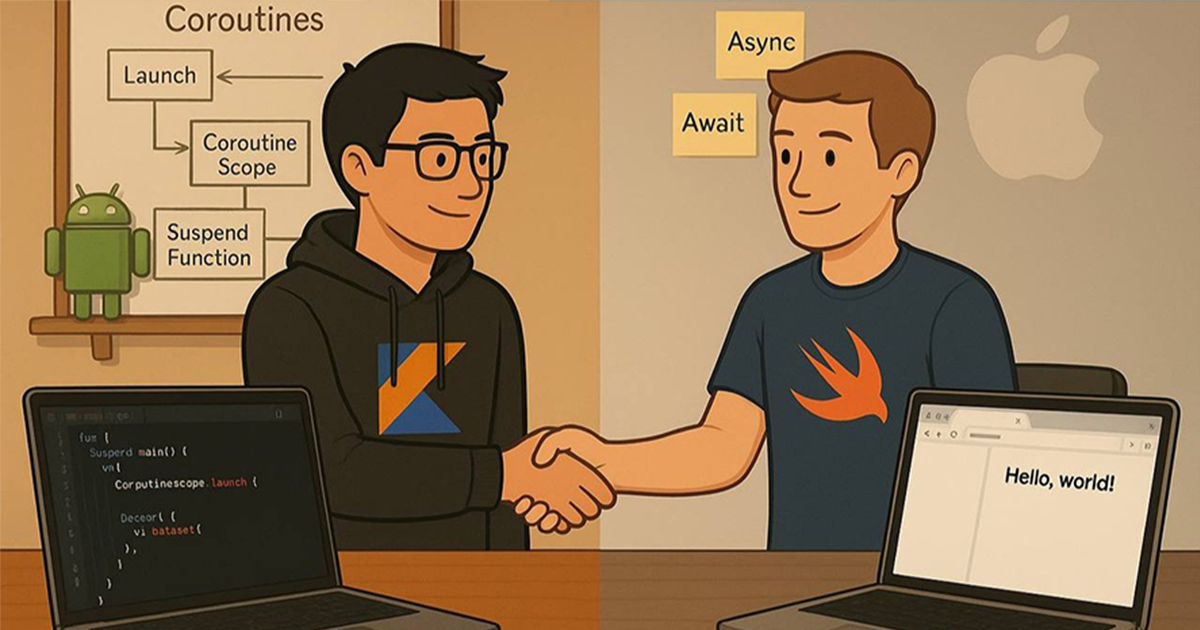Kotlin vs Swift: How Mobile Developers Can Learn from Each Other
Kotlin and Swift are the official languages for Android and iOS development. Both aim to improve developer productivity, safety, and app performance. Although they solve similar problems, the approaches they take are often different. This article compares these two languages and suggests how they could benefit from adopting each other’s best practices.
1 . Core Language Features
Null Safety (Kotlin) vs. Optionals (Swift)
Kotlin uses nullable types, denoted with the ? operator. This prevents NullPointerExceptions
at compile time, reducing the chance of runtime errors. However, it can
introduce extra syntax when working with Java libraries.
On the other hand, Swift uses Optionals, which require explicit unwrapping through constructs like if let, guard let, or optional chaining. While this makes the syntax cleaner, force-unwrapping (!) can lead to runtime crashes if misused.
Opinion:
If Kotlin adopted Swift’s guard let construct, it would
allow for cleaner early exits from functions, improving readability.
Conversely, Swift could improve its handling of null safety by taking a
cue from Kotlin’s seamless interoperability with Java.
2 . Concurrency Models
Coroutines (Kotlin) vs. Async/Await (Swift)
Kotlin’s coroutines allow developers to write sequential-looking asynchronous code while managing background tasks safely. They use structured concurrency, organizing work within defined scopes, and handle cancellation gracefully. Developers, however, need to manage thread dispatchers with care.
Swift also uses structured concurrency. Since Swift 5.5, async/await is backed by Task and TaskGroup,
letting developers structure asynchronous code in a clear, hierarchical
way — much like Kotlin’s structured coroutines. It integrates smoothly
with DispatchQueue and brings a linear style to async code, though it requires iOS 15+ for full adoption.
What They Could Learn:
Kotlin could benefit from Swift’s TaskGroup for managing groups of concurrent tasks more elegantly. Swift might gain flexibility by adopting a concept like Kotlin’s CoroutineScope to handle lifecycle-aware async work, especially in more complex applications.
Controversial Take:
Swift’s async/await is a welcome improvement, but for
simple apps, it can feel overrated. Not every use case justifies a whole
concurrency hierarchy.
3 . UI Frameworks
Jetpack Compose (Kotlin) vs. SwiftUI (Swift)
Jetpack Compose is Kotlin’s declarative UI toolkit, reducing boilerplate and offering live previews. It’s powerful and modern, though like any new paradigm, it introduces a learning curve for developers moving from imperative, XML-based layouts.
SwiftUI is Apple’s declarative UI framework, making it easier to build interfaces across Apple platforms with minimal code. It still lacks some advanced components and is limited to iOS 13+.
Personal Touch:
Having worked with both, I find Jetpack Compose’s ability to mix with
existing Views a strong advantage for backward compatibility. SwiftUI,
however, wins with its seamless cross-platform integration within
Apple’s ecosystem.
What They Could Learn:
Kotlin could borrow SwiftUI’s unified cross-device support, while Swift
might take advantage of Compose’s backward compatibility strengths for
integrating with older UI systems.
4 . Architecture Patterns
MVVM: Kotlin vs. Swift
Kotlin typically uses MVVM with ViewModel and either LiveData or StateFlow. This helps manage UI data and survive configuration changes, but it can result in bloated ViewModels if not carefully structured.
Swift also uses MVVM but with ObservableObject and @Published
properties for tight SwiftUI integration. It’s elegant and concise,
though two-way bindings can get tricky in complex interfaces.
What They Could Learn:
Kotlin might benefit from Swift’s streamlined way of handling UI state,
especially for apps heavily relying on SwiftUI-like patterns. Swift
could consider adopting Kotlin’s StateFlow for more efficient UI state management.
5 . Data Persistence
Room (Kotlin) vs. Core Data (Swift)
Kotlin’s Room provides a lightweight SQLite wrapper with strong coroutine support. It offers compile-time validation of SQL queries, which reduces runtime errors. However, schema migrations in Room can still be challenging for complex data models.
Core Data is Apple’s persistent framework, tightly integrated into iOS. It’s efficient for memory management and object graph modeling. Yet, it comes with a steep learning curve and makes schema migrations unnecessarily complicated.
Personal Touch:
I once struggled with Core Data migrations. It’s a pain point I wouldn’t wish on anyone.
Opinion:
In my experience, Room’s compile-time SQL validation significantly
lowers the chances of database-related bugs. Swift could certainly
improve by introducing something similar, ensuring developers write
error-free SQL queries.
What They Could Learn:
Swift could benefit from Room’s compile-time query validation to reduce
database-related errors. Kotlin might learn from Core Data’s deep iOS
integration to provide a more seamless platform-specific persistence
solution.
 Conclusion
Conclusion
Kotlin and Swift are both modern programming languages designed to
improve the mobile development process. While they share similar goals,
each takes a different path to reach them. If Kotlin adopted some of
Swift’s features, like guard let and TaskGroup, it could refine its concurrency model further. Meanwhile, Swift could make its asynchronous code more flexible with Kotlin’s CoroutineScope and reduce boilerplate with Kotlin-style data classes.
The ongoing evolution of both languages proves one thing: innovation in one ecosystem often sparks great ideas in another. Borrowing the best from each other can only make our Android and iOS apps more reliable, maintainable, and enjoyable to build.
To be continued… when Swift explores the power of @annotations
References:

